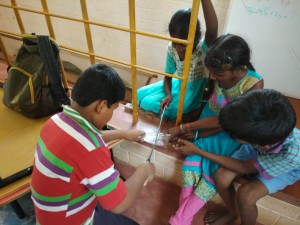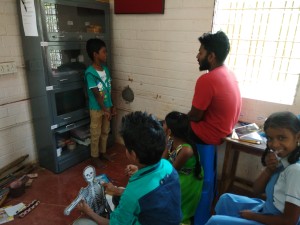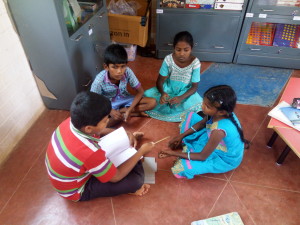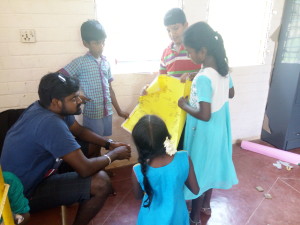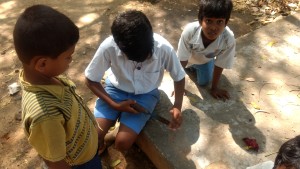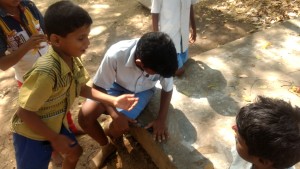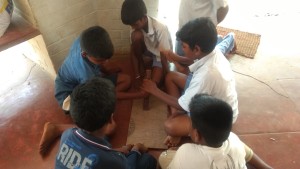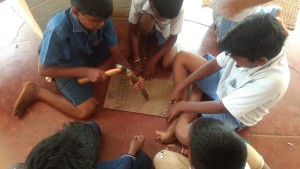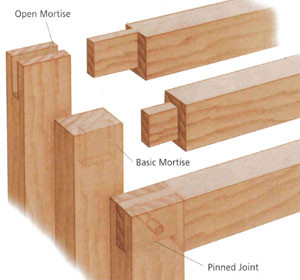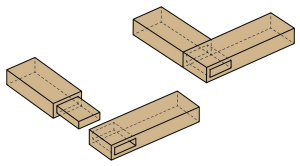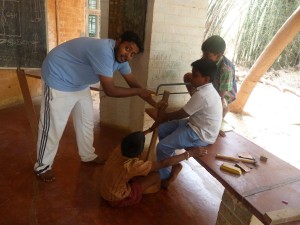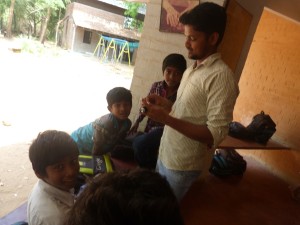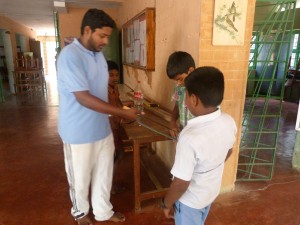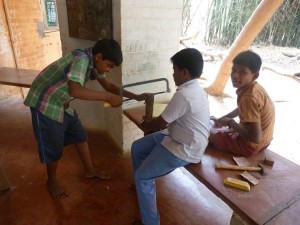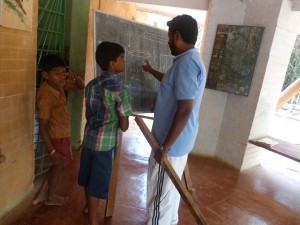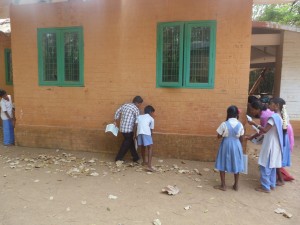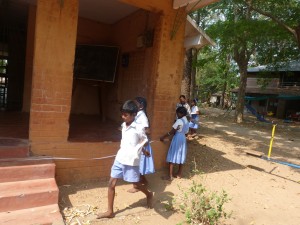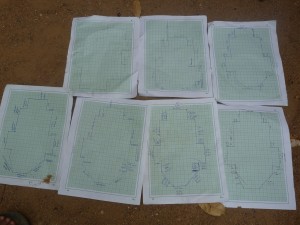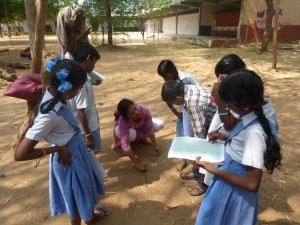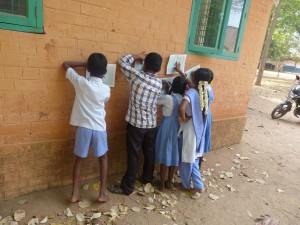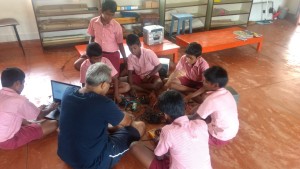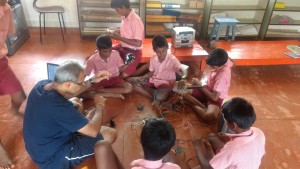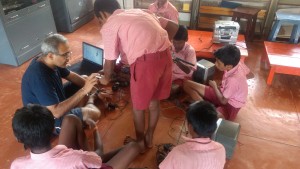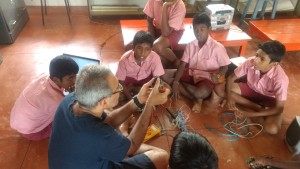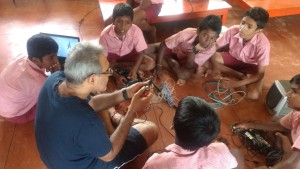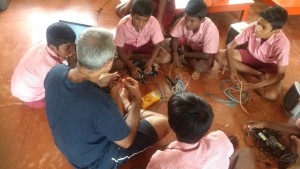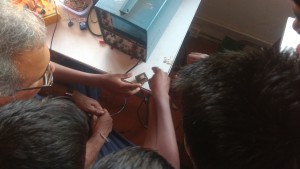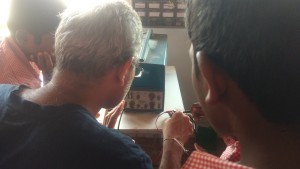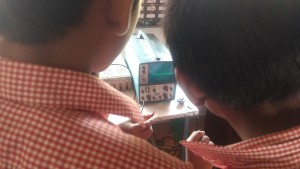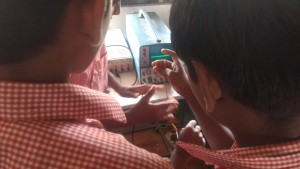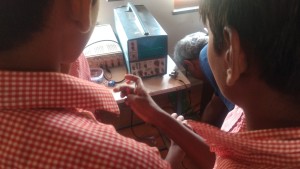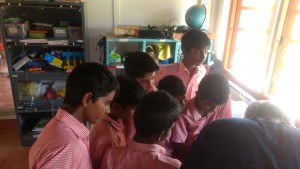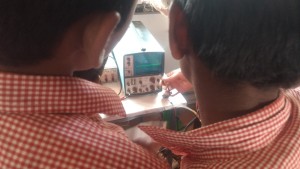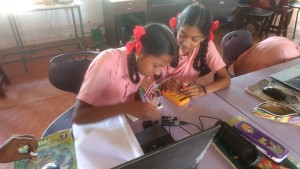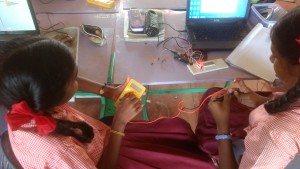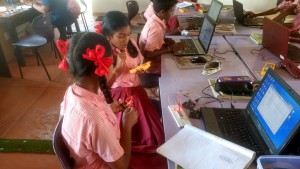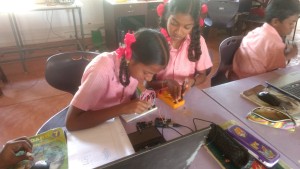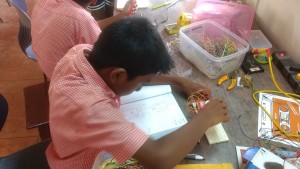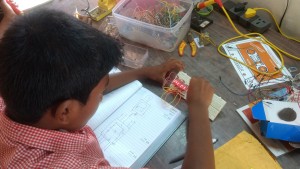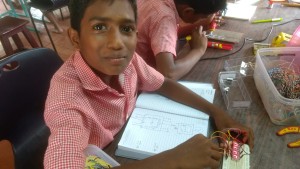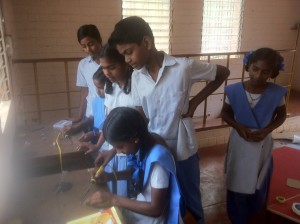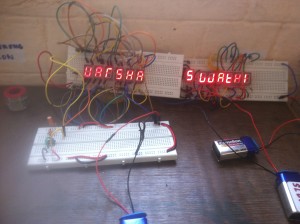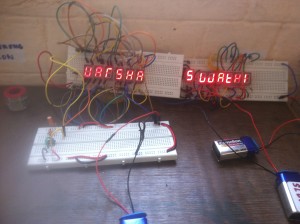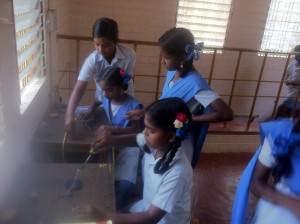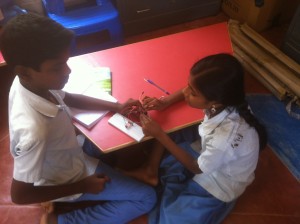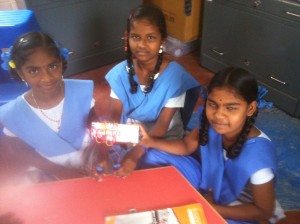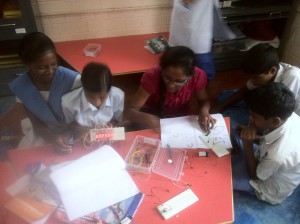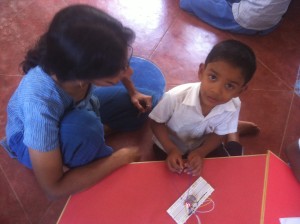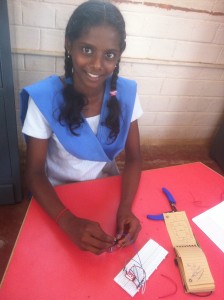The 5th and 6th grade children at Isai Ambalam were preparing for the presentation on the last day for their parents. We decided that they can perform2 presentations(Water EBD and Skeleton) and a demo on Measurements. The 12 children were equally split into groups of 4 and each group chose which topic they wanted to present to the audience. I worked with Water EBD group and Naveen worked with the Skeleton group to prepare for the presentation. The water EBD group spoke very confidently in Tamil when they were presenting it to me in Tamil. But they found difficult to replicate the same in English.
Isai Ambalam school on Saturdays
The start of the Saturday classes in Isaiambalam School has enabled a lot of different exposures with various people to the children. Some of the elder students wanted to model Sanjeev’s house with plywood. Then the list was made to buy the materials required and the students came up with the following:
- Saw x 2
- Hammer x 2
- Sand paper x 1m
- Chisel x 1
But then we decided to use the old chisel that i had already in my arsenal, Sharpening so it was.
Once the chisel was ready
We started to carve in the windows with the correct dimensions, we took a ratio of 1:10 and descaled the House for the wood model.
Then came the task to build a real door, the children kept on a halt the house model and started to inspect room that required the door and it continued to the next class;
The old mushroom shaped room with no door:
We decided to build a door with some unused wood that was ageing without a purpose. This gave the children a view into measurement. They started out by measuring the dimensions of the door and marked the appropriate onto the wood. Then came the challenge of what joint to select, and we selected an open mortise with a pinned corner.
So began the sawing, hammering, and chiseling works 🙂
Sundranandhan
———————–
We wanted to make the joints perfect and decided to carve the wood to have a
In Isai Ambalam school on Saturdays many activities are done with the students. Last Saturday we did carpentry, gardening. Some learnt electronics and some played strategy games in Isai Ambalam Stemland. We also use math for measuring the wood. We also taught how to cut the wood with a saw.
Prathap.G
Water project with EBD
Learning Outcomes 9th grade 2016/17
Pravin:
- He is able to solve the rubiks cube in about a minute
- He is capable of designing models in Blender and printing them out in the 3D printer.
- He can solder components.
- He is comfortable in solving visual questions from the book like mensuration, geometry.
- He is able to fill his plan
Kabilan:
- He is able to solve the rubiks cube in about a minute
- He is capable of designing models in Blender.
- He can solder components.
- He completes chapters on his own and is independent
- He is fairly good in most of the strategy games in solving puzzles and
- He helps other children when they need help.
- He is competent in programming using Scratch and also helps others in Scratch
- He is able to fill his plan
Ajai:
- He is able to solve the rubiks cube in about a minute
- He can solder components.
- He is fairly good in most of the strategy games.
- He helps other children when they need help.
- He is competent in programming using Scratch and also helps others in Scratch
- He can work independently
- He is able to fill his plan
Sangeetha:
- She has become more independent in the 3rd term
- She is able to plan better
- She is able to complete chapters in time.
- She helps others if she knows
- She is able to fill her plan
Anishvathi:
- She understands every question and solves it
- She helps others if she knows
- She can solder components
- She is able to work on projects in Scratch
- She is able to complete more chapters than before
- She is able to fill her plan
Preethi:
- She is independent.
- She works with her peers
- She is able to fill her plan
Rathi:
- He is able to solve the rubiks cube in about a minute
- He is capable of designing models in Blender and printing them out in the 3D printer.
- He can solder components.
- He can program in Alice
- He is fairly competent in Scratch programming
- He helps others when they ask him
- He is independent
- He completes chapters on his own
- He is good in solving puzzles and strategy games
- He is able to fill his plan
Sharmila:
- She is able to complete chapters
- She is able to do projects using Scratch
- She helps others when they ask
- She can be independent
- She is able to fill her plan
Yuvaraj:
- He is able to solve the rubiks cube in about a minute
- He can solder components.
- He completes chapters on his own and is independent
- He is able to work on electronic projects
- He is able to help others when they ask him
- He is competent in Scratch programming
- He is good in solving puzzles and strategy games
Swetha:
- She is able to work with her peers
- She is able to make projects with her peers
- She is able to program in Scratch
- She is able to fill her plan
- She is able to complete more chapters than before
Dakshini:
- She is able to complete the chapters independently
- She helps others when they ask her
- She is able program in scratch
- She can solve the rubiks cube
- She is good in strategy games and in solving puzzles
Sanjeevika:
- She is able to complete more chapters than before
- She is able to help others in comprehension problems
- She is able to fill her plan
Preethika:
- She is fairly competent in making projects in Scratch
- She is able to fill her plan
- She is able to work independently
- She is able to work with her peers
- She is good at strategy games
- She is able to solder components and work on electronics
Fevina:
- She is able to work independently
- She is able to complete the chapters on her own
- She helps others when they ask her
- She is able to work with her peers
- She is able to solve puzzles
Muthazhagi:
- She is able to complete chapters
- She is able to work with her peers
- She is able to fill her plan
What the 9th graders were proud of 2016/17
Pravin:
- I was proud when I printed the 3D models, ie,House, Caterpillar
- When I did the Stemland display board with Naveen
- I feel proud to have nice buddy(Deivakaran)
- When I did arduino project that alarms for 1 min
Kabilan:
- When I did (a+b+c)^3 in blender.
- I feel proud when see my improvements in everything(eg, scratch, studies, strategy games etc..)
- When I did disco light with Pravin
Ajai:
- The project I did for surds using Scratch. I feel very proud.
Sangeetha:
- I was proud of the marks I got in 2nd term
- I am able to exercise faster and on my own
Anishvathi:
- I am proud of the project I did in Practical Geometry.
- Soldering Vega Kit
Preethi:
- I felt proud when I did project with Sanjeev on graphs.
Rathi:
- The 3D model I am doing now in Blender(full human)
- All the scratch projects
- Soldering light sensor
- Won Sorry game in 5 moves
- I felt proud when I completed the ‘Desparado’ puzzle
Sharmila:
- The graph project on scratch
- I completed 4 chapters this term very quickly
- I am able to do project on my own
- I am proud I am not wasting time
- I am independent
- I feel proud to be a buddy.
- Iam concentrating well
- I have improved in playing games
Yuvaraj:
- Electronic project – vega kit(eg, sensor)
- When working arduino
Swetha:
- I improved a lot in Scratch. I am proud about it.
- When I am working on my own.
- When I learnt new things in the workshop.
- When I do Stemland responsibilities.
Dakshini:
- I am proud of my 1st term mark
- When I did a project to find square root in Scratch.
- When I complete chapters quickly
Sanjeevika:
- I completed two projects in Scratch in the second term. I am proud about it.
Preethika:
- When I do Scratch project eg, graph(many people saw it and said it was nice)
- When I showed and played games to other people.
- When I practice triads.
Ground water model
As a part of their water EBD children made a model for ground water. We got a broken aquarium from Kavitha (Head teacher of Isaiambalam).
Step 1: We placed three compressed bricks inside the aquarium to hold the mesh. We left a space for the water to be collected which is the Aquifer.
Step 2: We placed the mesh on top of the bricks.
Step 3: We put a layer of pebbles.
Step 4: We put few layers of different soils to represent soil layers under earth.
Step 5: Poured water on the top and after sometime it got collected between the bricks which represented Aquifer.
![IMG_20170325_101033010_HDR[1]](http://www.auraauro.com/wp-content/uploads/2017/04/IMG_20170325_101033010_HDR1-300x169.jpg)
![IMG_20170325_101035596_HDR[1]](http://www.auraauro.com/wp-content/uploads/2017/04/IMG_20170325_101035596_HDR1-300x169.jpg)
![IMG_20170325_101029715_HDR[1]](http://www.auraauro.com/wp-content/uploads/2017/04/IMG_20170325_101029715_HDR1-300x169.jpg)
![IMG_20170325_101830041_HDR[1]](http://www.auraauro.com/wp-content/uploads/2017/04/IMG_20170325_101830041_HDR1-300x169.jpg)
Water EBD
Children of Isaiambalam (4th to 6th Graders) school have been doing an EBD (Education By Design) project on Water. The school was running out of water for the past 3 months. Children was struggling to go to the rest room and for drinking water.
Then the problem was fixed by lowering the Bore well pipe by 150 feet. Now the total depth of the Bore well is 350 feet. We decided to take a real time problem for their EBD. Then the children started to discuss in groups what were the real reasons behind the shortage of water. They had lot of assumptions. For example; They thought that the recently drilled Bore well near the school took away lot of water, The motor was not good enough, The pipe was blocked by the sand etc.
Through EBD children were exposed to learn Maths, English, Tamil and Science.
Maths: They measured length of pipes, Built a pond in school where they measured the Diameter, depth, area etc (Will talk about the pond later in another blog).
English: They wrote whatever they learned in their note book in English. The younger children who were not able to write in English wrote in Tamil first and then translated it back to English. Few children discussed the project in English and presented to the whole group in English.
Science: Children learned the Water Cycle. They learned what was ground water and its process of settling down in the Aquifers. They watched video to learn few concepts like Process of drilling Bore well, Ground water, Water cycle etc. They even saw the process of drilling Bore well near their school.
Visits:
Soil scientist: A soil scientist Deoyani from Auroville visited the children and shared her experience with soil and water. She gave few ideas for rain water harvesting. Children were very excited and asked her questions. She pulled out few ideas for saving water from their mouths.
Aaranya forest: Children had a night stay in Aaranya forest (Puthurai). Saravanan (Person who takes care of the forest) took them for a walk through the forest. Children learned new tree names, their history and uses. We had a discussion with the children after the dinner on what they learnt from Saravanan. Children wrote it down in their notebooks. They were very thrilled to know that before the forest fully grew there were 50 different kinds of birds. And now over 250 different kinds of birds visit and lives in the Aaranya forest. Children saw how they were doing rain water harvesting. In the morning we had bridge crossing and rope gliding which were very exciting for the children and myself.
Output:
Unfortunately children had only 12 days for their water EBD. We asked the children to present to others what they learned through this project.
- Kavya and Guru created a book.
- The pond
- Model for ground water system
- Model for hand pump
- Hand sketch for rain water harvesting in their school
- Chart work on
- water cycle,
- ground water,
- Drilling bore and
- Wastage of water
Outcome:
- They were able to work with different age group children.
- They were able to build a pond on their own.
- They were Able to write English sentences.
- Some children were able to speak in English.
- Two children were able to write a book on their own.
The children took up responsibilities for their learning and materials, They had the courage to create models and worked with each other with equality which were aligned with values of STEM Land.
Salvaging wires and hacking a 240V to 9V transformer from an adapter
The 7th graders from Udavi School took a project on creating a PA system. To start of we required a lot of wires so the quest for salvaging wires began. The students picked every wire possible in STEMLAND that was not being used, we had a long Ethernet cable that was damaged and removed the outer casing and rolled up the inner wires. Once the required amount of wires were acquired we needed a power supply, a broken adapter that was found among the damaged equipment’s came into good use. We opened the case and took the transformer.
Then the primary and secondary winding s were checked for connectivity using a multi-meter.
Next the transformer was hooked up to a plug and carefully soldered and covered using heat shrink cables for maximum protection from the input voltage, thus it was ready to be tested.
The output of the transformer was connected to the oscilloscope, but only showed 2V to 3V. But when tested with a multi meter it showed 8.5V the expected voltage. This was a little confusing. In the end by accident after removing the power we touched the transformer it was really hot. the adapter that the transformer was salvaged must have had burnt the core of the transformer, a while back. Then the hunt for a new transformer began.
7th girls and boys working with SSD (Seven Segment Displays)
The SSD’s had really picked up during the project period with the 7th children after Barani had created a project. The girls started to understand and light up the letters they wanted. They used the multi meter in diode mode to test whether the SSD’s where common anode or common cathode in configuration. Initially they were powering up the SSD’s with a 9V battery, then they started to use the arduino.
link to Barani’s Project: http://www.auraauro.com/circuits-simulations/hardware-clock/
Along with them Nirmal had also joined the team and started to understand SSD’s with the support of Shalini and Sushma.
Soldering Session
7th graders of Isai Ambalam:
Student learnt about soldering in the Stem land. I taught soldering a battery connector to 7th students with a male male connector so that it can be used in a bead board. Then they were able to use the battery connector to connect with a 7 segment display. They learnt to connect a 7 segment display and they came to know about types of 7 segment display. Then they were able to light their names using the 7 segment display.
Prathap


